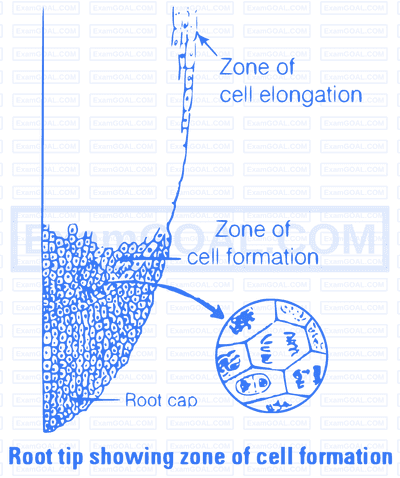What are the structural characteristics of
(a) meristematic cells near root tip
(b) the cells in the elongation zone of the root
(a) Meristematic cells near root tip the cells of this region are called Root Apical Meristems (RAM) and are in active state of division, thus their number increases continuously. The cells of this region are thin walled with dense cytoplasm and large nucleus. They have the ability to divide and self perpetuate.

(b) The Cells in the Elongation Zone of the Root This region is situated just above the meristematic zone. In the cells of this zone, a large number of small vacuoles develop and later these vacuoles fuse to form one large central vacuole filled with cell sap. The cells are elongated in this region.
Explain in 2-3 lines each of the following terms with the help of examples taken from different plant tissues.
(a) Differentiation (b) De-differentiation (c) Re-differentiation
(a) Differentiation is permanent in size, structure, composition and function of cells, tissue or organs. For example the meristematic tissues in plants gives rise to new cells which mature and get differentiated into special tissue or an organ of the plant, e.g., cells, distal to root apical meristem form root cap, cell of the periphery form epiblema, followed by cortex, endodermis, pericycle and vascular.
(b) De-differentiation is the process of despecialisation of differentiated cells so that they again become differentiated and able to divide. e.g., in dicot stem, the cortical cells get de-differentiated and become meristematic to form cambium (interfascicular cambium, and fascicular cambiums).
(c) Re-differentiation The cambium cells thus formed, again re-differentiate to form secondary cortex cells secondary xylem and phloem elements and phelloderm in case of secondary growth of woody dicot plants.
Auxins are growth hormones capable of promoting cell elongation. They have been used in horticulture to promote growth, flowering and rooting. Write a line to explain the meaning of the following terms related to auxins.
(a) Auxins precursors (b) Anti-auxins (c) Synthetic auxins
Auxin is an important plant phytohormone required for the growth and development of every plant in its life cycle.
(a) Auxin Precursors are raw materials required to initials synthesis of auxins. IAA is synthesised from tryptophan, adenine compounds and derivatives of carotenoids.
(b) Anti-Auxins are compounds that inhibit action of auxins, e.g., p-chlorophenoxy isobutyric acid (PCIB), TIBA.
(c) Synthetic Auxin These are synthesised not by plants but artificially by man, e.g., 2-4 D (weedicide), NAA, dicamba and IBA, (Indole Butyric Acid) which are natural as well as synthetic auxin.